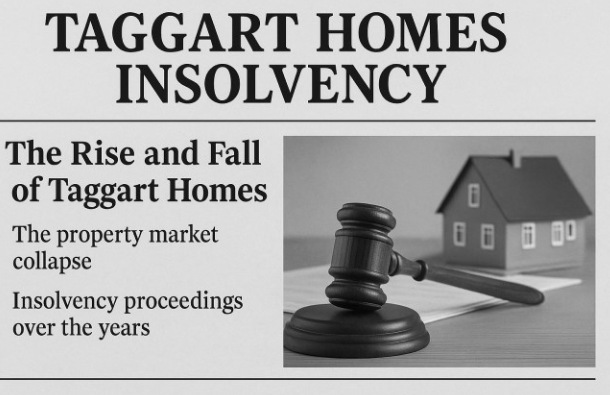Taggart Homes insolvency is a topic many people in the UK and Ireland are talking about. The company, once a big name in building homes, has faced many ups and downs. For years, it promised beautiful houses and new projects, but money problems kept coming back. Many people, like small builders, suppliers, and even families waiting for homes, have felt the pain of these financial troubles. Understanding why Taggart Homes insolvency happened is important, because it shows how big companies can fall when debt and risky choices get too heavy. This is not just about one builder; it is about lessons for the whole property market.
Taggart Homes insolvency is not a single story—it is a long road with many twists. First, the company grew too fast, then the 2008 financial crash hit hard. Later, new companies using the Taggart name tried to keep the business alive, but debt still followed. In 2025, the company went into a Company Voluntary Arrangement (CVA), which is a special plan to pay back money over time instead of closing down fully. While this gave some hope, many creditors and workers are still waiting to see if they will be paid in full. This story is not finished yet, and it shows why people should be careful when a company keeps changing names but still carries old debts.
Table of Contents
Taggart Homes Insolvency: The Full Story in Simple Words
Taggart Homes insolvency began after a long run of building homes that many people liked. The company grew fast, borrowed money, and took on many projects at once. When the housing market turned, work slowed and bills grew bigger than cash could cover. Suppliers, small builders, and banks waited for payments that did not come on time. Families who wanted new homes had to wait longer. Over years, parts of the business went into administration and some companies closed. New firms using the Taggart name later appeared, but debt and legal fights kept following. Today the story is about unpaid bills, a CVA plan, and hope that fair rules will help creditors and buyers heal and local town workers too.
Why Taggart Homes Grew Fast but Fell Even Faster
Taggart Homes grew fast because leaders wanted big projects and quick profit. They bought land, hired teams, and promised many houses in a short time. Banks gave loans and suppliers trusted them to pay later. This fast growth hid weak planning and little spare money for slow times. When costs rose or sales slowed, the company had little cash to keep building. Small mistakes became big problems because the company had borrowed so much. The firm tried to keep work going, but new problems used up savings. Many projects stalled and people who worked or supplied materials waited for money. In the end, fast growth without safe planning helped cause Taggart Homes insolvency and a long fall. and trust fell.
2008 Crash and How It Broke Taggart Homes’ Future

The 2008 crash hit the whole housing market and it hit Taggart Homes hard. People stopped buying homes and banks tightened loans. Prices fell and projects that looked safe became risky. Taggart Homes had lots of work and big loans, so the sudden change cut its cash very fast. Builders could not pay suppliers and some sites closed. The company needed new money but lenders were not willing to help. This led to administrators stepping in to try to save value and pay debts. Workers lost jobs and families waiting for homes were left unsure. The 2008 shock changed the company forever and set the scene for later Taggart Homes insolvency troubles. and left long scars across many towns too.
New Companies, Old Problems: The Rebranding of Taggart Homes

After the big problems, new companies using the Taggart name appeared. They said they were different but many projects and promises stayed the same. This rebranding gave hope to workers and buyers who wanted jobs and homes to finish. But old debts, unpaid bills, and legal cases did not vanish. Some creditors found it hard to trace money across different companies. This made it slow and hard for suppliers to get paid. People worried that rebranding was a way to avoid past debts. Regulators and courts had to check each company link to see who was truly responsible. The mix of new names and old debts made the Taggart Homes insolvency story more complex. and trust fell even further now.
Taggart Homes Insolvency 2025: What the CVA Really Means
In 2025 Taggart Homes entered a CVA to try to fix money problems and keep trading. A CVA is a plan where a company promises to pay back some money over time while it keeps working. For Taggart Homes, the CVA showed big debts and many people and firms were owed money. The plan can help the company finish some homes and pay part of what it owes. But it does not always mean full repayment for everyone. Some creditors may get only part of what they are due. The CVA also needs approval from a group of creditors and then monitoring. For many, the CVA is a slow path to try for fairer outcomes. and time will tell. Soon.
How Creditors Lost Millions in Taggart Homes Insolvency
Many creditors lost money when Taggart Homes ran into trouble. Small suppliers and local builders often waited months and sometimes years to be paid for work they had finished. These firms had their own bills to pay, and the delays hit their cash badly. Bigger lenders and banks also faced losses when loans were not repaid. Some investors who bought projects lost parts of their money when developments stalled. Legal costs to chase debts made things worse. When one company in a group failed, money could not move easily to other parts of the business. This made it hard for creditors to recover what they were owed and many faced big financial pain. and small firms sometimes closed for good.
Legal Roadblocks: Why Creditors Still Struggle for Payment
Creditors often face legal roadblocks that block or slow payments after a collapse. When a building group has many companies, it can be hard to trace which firm holds the money or the contracts. Courts and insolvency rules set an order for who gets paid first, and some suppliers rank low in that order. Legal fights over who owes what take time and cost money, which lowers the pot available for payment. A CVA can pause claims while a plan runs, leaving creditors waiting. Some creditors must start new court claims to try to recover money, but legal fees eat their chances. This maze of rules makes Taggart Homes insolvency hard to untangle. and hope fades for small business owners.
Is Taggart Homes Still Alive or Slowly Closing Down?
People ask if Taggart Homes is still alive or slowly closing down. The short answer is it is still trading under a CVA, so some work keeps going and some staff still work on sites. That means houses can still be finished and some payments may come in. But the CVA also shows the firm has big debts and a plan to fix them over time. If the plan fails or money does not appear, the company could enter liquidation and close sites. For now, builders and buyers watch each update closely. The future is not sure and many say only time and clear accounts will answer the question. and regulators may step in to protect buyers’ rights and deposits.
Lessons from Taggart Homes Insolvency for Builders and Buyers

Builders and buyers can learn many lessons from Taggart Homes insolvency. Builders should not borrow too much for fast growth and must keep clear accounts for hard times. They should pay suppliers on time and be honest with workers. Buyers should check a builder’s past and ask if warranties and deposits are protected. Lawyers and advisors can help spot risky contracts. Small firms should build safety money for slow months. Governments and regulators may push for clearer rules so buyers and suppliers are safer. The main lesson is simple: steady, careful work and clear paper rules help protect people from losing money when a builder faces trouble. and ask questions early to stop big losses and protect families too, always.
Conclusion
I wrote simple notes so you and others can read fast.
This story shows how money, trust, and clear papers matter.
If builders plan slow and safe, people lose less.
Watch the CVA news to know what will happen next.
I hope these short lessons help buyers and small firms.
Ask questions, keep records, and protect deposits when you can.
Big names can fail, so small checks keep families safe.
Stay careful and share what you learn with others.
FAQS
Q: What is a CVA in simple words?
A: A CVA is a plan where a company promises to pay some money back over time while it keeps working.
Q: Will all creditors get paid after Taggart Homes insolvency?
A: Not always. Some may get part of what they are owed and others may get little or nothing.
Q: How can buyers protect their money?
A: Check builder history, ask for deposit protection, get clear contracts, and keep copies of all papers.

